Rabbits can be affected by both endo and ectoparasitic infections. While some of these can display clinical signs, others may be asymptomatic or show very mild clinical signs, especially during the initial stages. As with other species presented to the practice a thorough clinical history and examination should be initially carried out and diagnostic tests are usually indicated to make a definite diagnosis (Keeble, 2018).
Some parasites are also zoonotic, therefore correct identification and treatment is vital.
Treatments are often based on information extrapolated from what is effective in dogs and cats, and products may not always be licensed for use in pet rabbits.
Ectoparasites
Mites
The rabbit fur mite, Cheyletiella parasitovorax is often termed as ‘walking dandruff’ as it is sometimes possible to see the mite moving with the naked eye (Figure 1). The non-burrowing mite lives on the keratin layer of the epidermis, causing crusting and scaling, and it is thought that the majority of domestic rabbits carry the mite with no clinical signs. However, when the rabbit's immune system is compromised either physically or psychologically, or normal grooming is inhibited, serious infestations can occur, especially in young or elderly rabbits (Keeble, 2018).
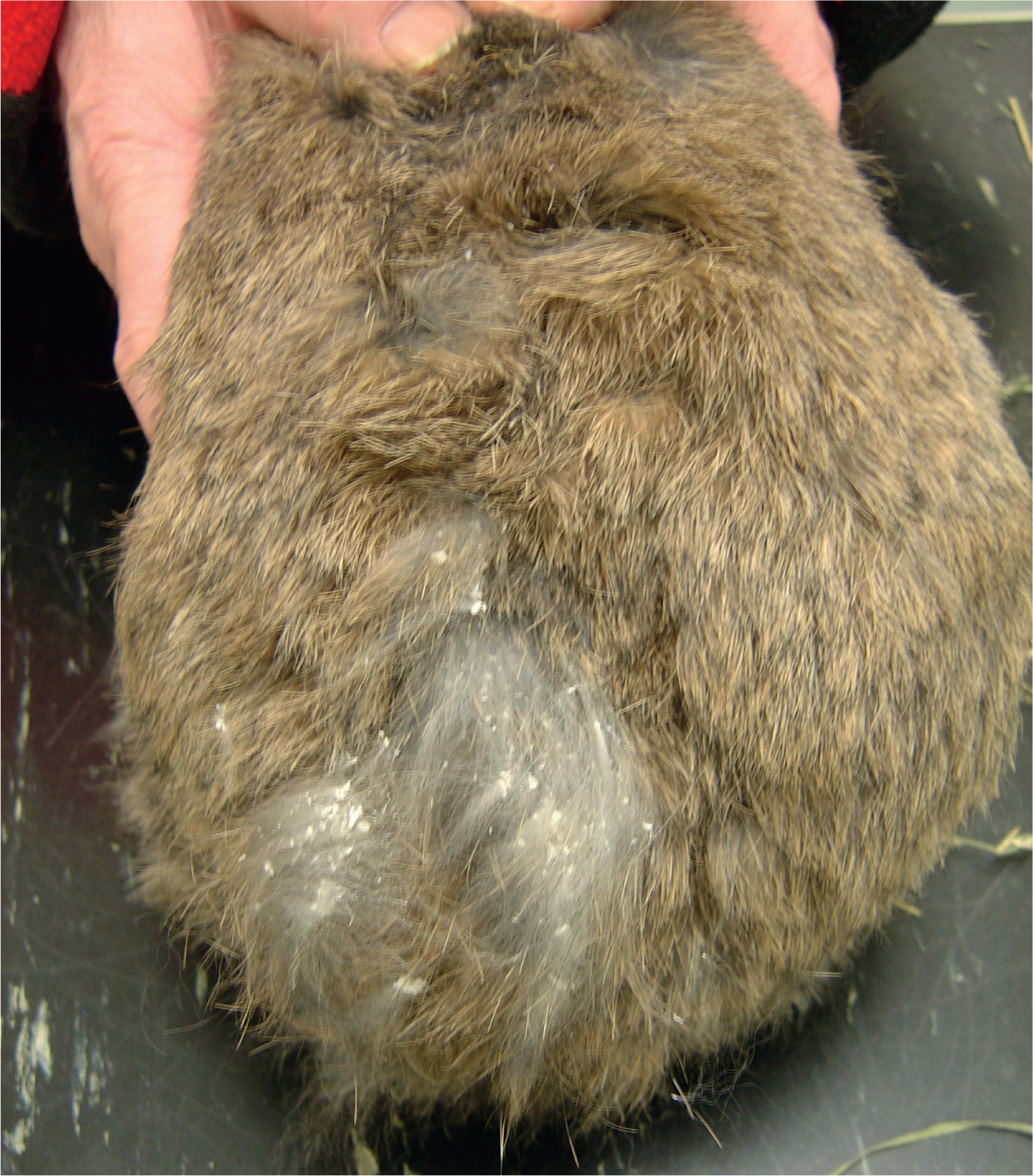
Initial clinical signs may be mild with small patches of dry, white, crusty skin between the shoulder blades and extending down the spine. When left to advance, the condition becomes extremely irritating and pruritic to the rabbit with patches of fur loss.
Cheyletiella is zoonotic and skin lesions may develop on the owner's arms, hands and neck, especially if they pick up the rabbit a lot. Lesions in humans tend to resolve once the rabbit has been successfully treated (Keeble, 2018).
Adult female mites are able to live off the rabbit, in the environment, for at least 10 days and are capable of moving from rabbit to rabbit to spread the infection. The eggs are attached to hair shafts and the life cycle lasts 2–3 weeks.
Infections can often be diagnosed from clinical signs, without the need for further diagnostic tests, but if necessary a skin brushing or acetate tape impression can be taken and examined under the microscope to look for mites and eggs. C. parasitovorax mites are rounded and have large, claw-like mouthparts. The adults are about 0.38 mm in length and have eight legs. Instead of claws, they have combs.
Ivermectin by subcutaneous injection every 10 days for three treatments, or topical selamectin, permethrin or ivermectin may be used to treat the mites (Keeble, 2018). Topical treatments should be repeated 10–14 days after the first dose and all in-contact rabbits should also be treated. The environment will need to be thoroughly cleaned and disinfected to prevent re-infestation and underlying cause/s identified. Topical ivermectin is licensed for use in rabbits. Selamectin and injectable ivermectin are used off license under the cascade system.
Another non-burrowing fur mite encountered in pet rabbits is Leporacarus gibbus. Unlike C. parasitovorax the mite is not zoonotic. Normally found around the rump area, clinical signs are only seen in heavy infestations and when observed these include pruritus and scurfing. The mite can be seen by the naked eye, especially in white haired rabbits. The bodies of both males and females are oval, with a rounded dorsal protrusion that extends slightly beyond the mouthparts. The legs of the male are much longer in relation to the body than those of the female. Treatment is with topical selamectin or imidacloprid plus permethrin topical combination drugs (Keeble, 2018). Imidacloprid is licensed for use in rabbits, but not for this purpose and therefore all products are used off license in accordance with the cascade system.
Psoroptes cuniculi, the rabbit ear mite, is a non-burrowing mite that may be referred to as ear canker, especially in older rabbit textbooks. During the early stages, clinical signs may be limited to occasional ear scratching or head shaking. As the mites multiply the infestation will extend from the ear canal to the pinna. At this point the crusty lesions will be abundant and the rabbit is likely to be suffering with intense irritation and head shaking (Figure 2). Skin lesions can spread to the face and neck, and the eardrum can perforate resulting in middle ear infection, with secondary pus formation (otitis media) and possibly even meningitis (Keeble, 2018).
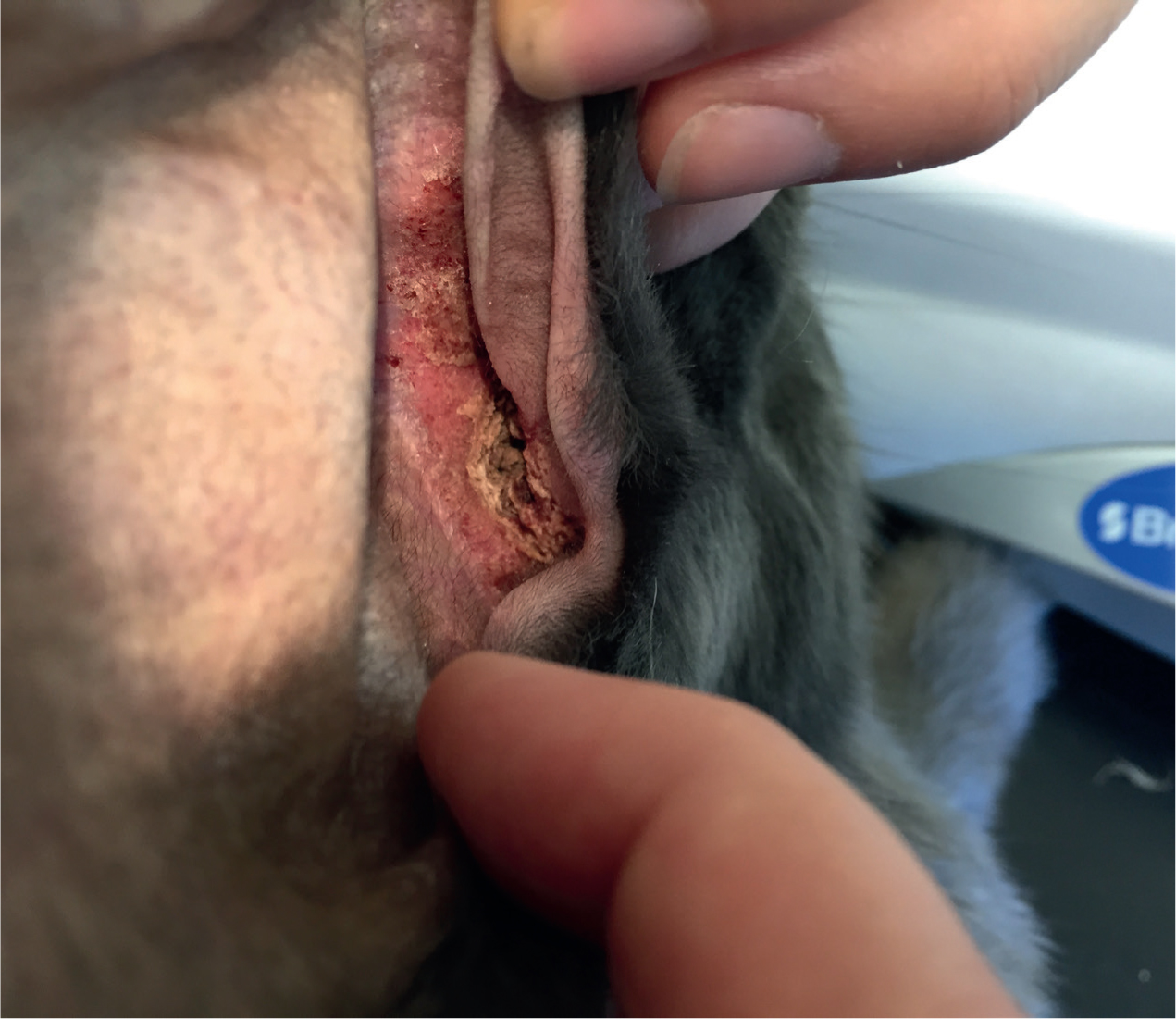
Infected rabbits pass on the mites to other rabbits through direct contact, or when shaking their head, allowing the eggs and mites to contaminate the environment. Therefore all in-contact rabbits must also be treated, even if they are not showing signs of infection.
Treatments include selamectin or moxidectin, both off license under the cascade system. These mites can also spread to other areas of the body during grooming (Wissink-Argilaga, 2017).
It is important not to manually remove the crusts from the ears (Figure 3). Once the mites have been killed these will resolve on their own. Attempting to remove them is painful for the rabbit and can cause damage to the ear canal lining. Analgesia is often required, especially if the condition has advanced.
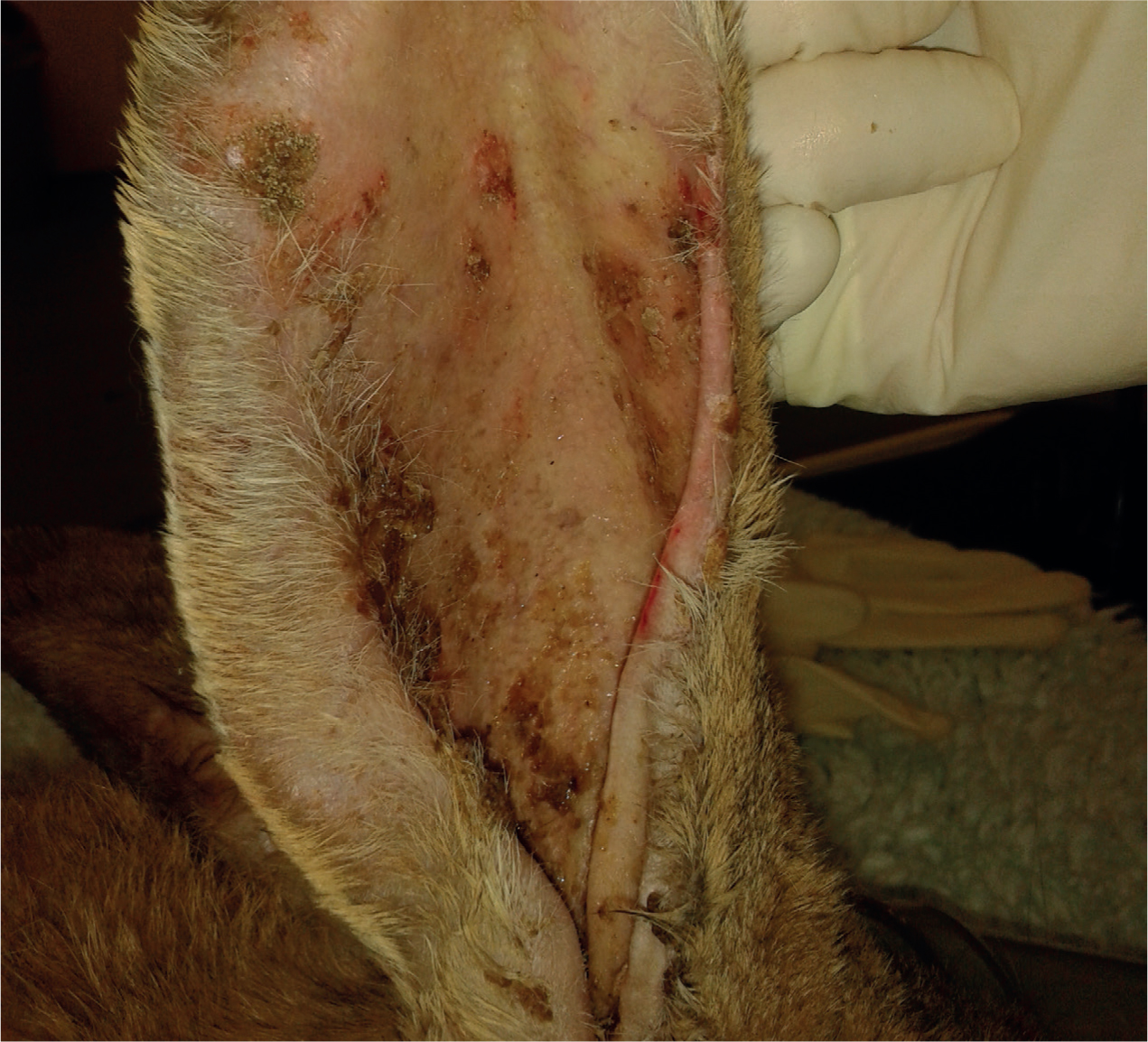
Harvest mites (Trombicula autumnalis) can be found on rabbits that live outdoors or in those with outdoor access. They are more commonly found in late summer or early autumn and appear as small, red mites. As they may be a carrier for myxomatosis, they are important to try and prevent and treat promptly. Commonly found around the ears and between the toes, rabbits pick them up from grazing areas or from the soil. Ivermectin or permethrin may be effective treatments in pet rabbits, although there are few data available on their efficacy against harvest mites (Keeble, 2018).
Demodex cuniculi has been found in skin scrapings taken from rabbits in the UK (Harvey, 1990), although it is not common. Affected rabbits seem not to show clinical signs.
Fleas
The rabbit flea (Spillopsyllyus cuniculi) is found on pet rabbits and is a common vector for myxomatosis. The cat flea (Ctenocephalides felis) and dog flea (Ctenocephalides canis) can also be encountered in rabbits that live with dog or cats or in infested premises (Varga, 2014).
Fleas are rarely life-threatening unless the rabbit is very young or small, or has a substantial infestation, since anaemia has the potential to occur. Live fleas may not be observed unless the infestation is advanced, but flea dirt in the coat will be evident (Figure 4).
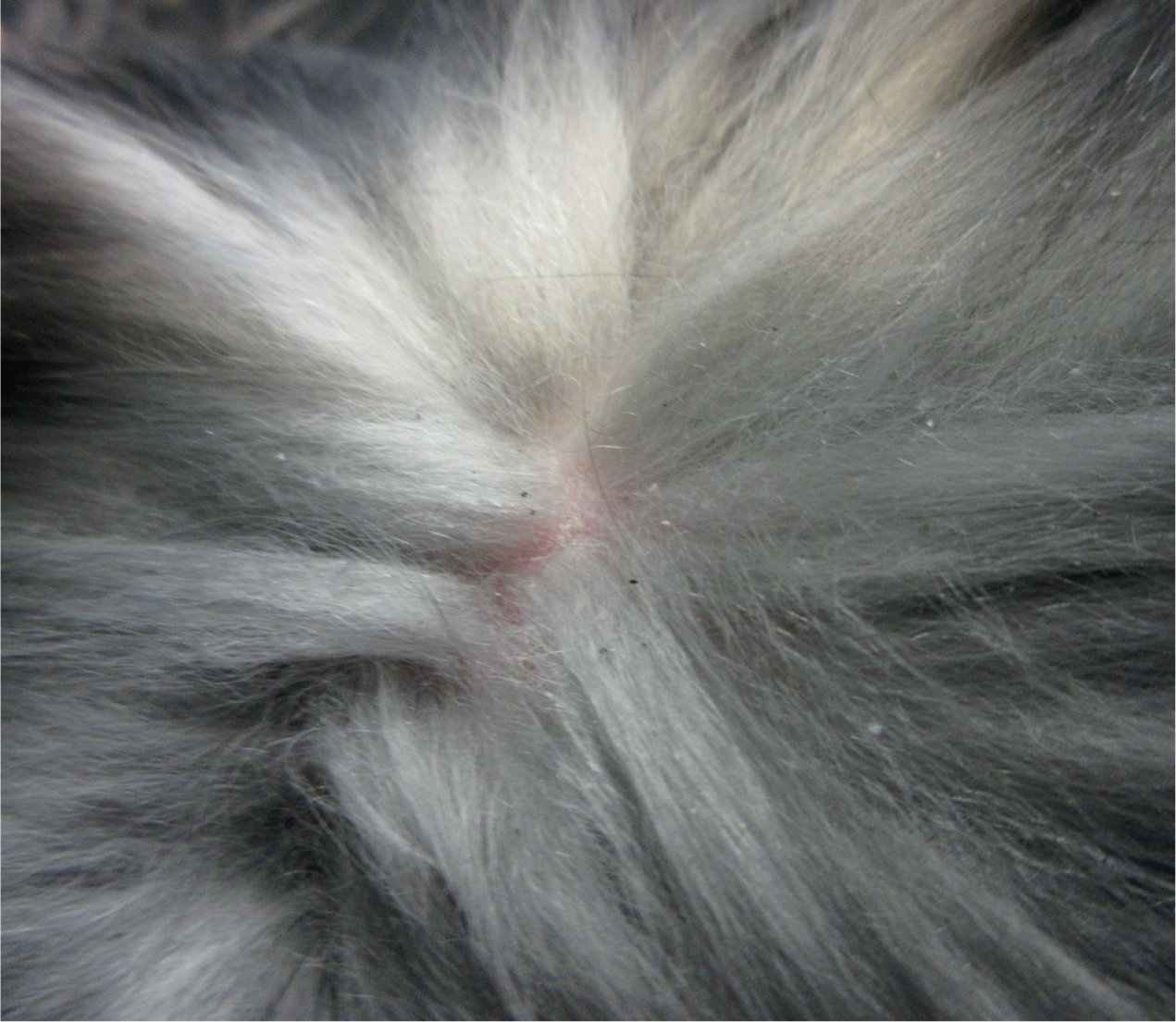
Imidacloprid or selamectin applied topically can be used. Selamectin is used off license under the cascade system. Fipronil should never be used in rabbits as the isopropanalol vehicle has been reported to cause adverse reactions and even death (Keeble, 2018).
Ticks
Ticks are rare in pet rabbits as they do not frequent areas that allow easy transmission. However, if cats or dogs in the household mix with pet rabbits, they are a possible route for transmission.
Ticks can transfer the myxomatosis virus and large numbers may result in anaemia (Figure 5). Careful removal of the ticks using a specific tick remover and/or treatment with subcutaneous ivermectin injection is recommended (under the cascade system, off license), as well as identifying the route of transmission to eliminate further infestations.
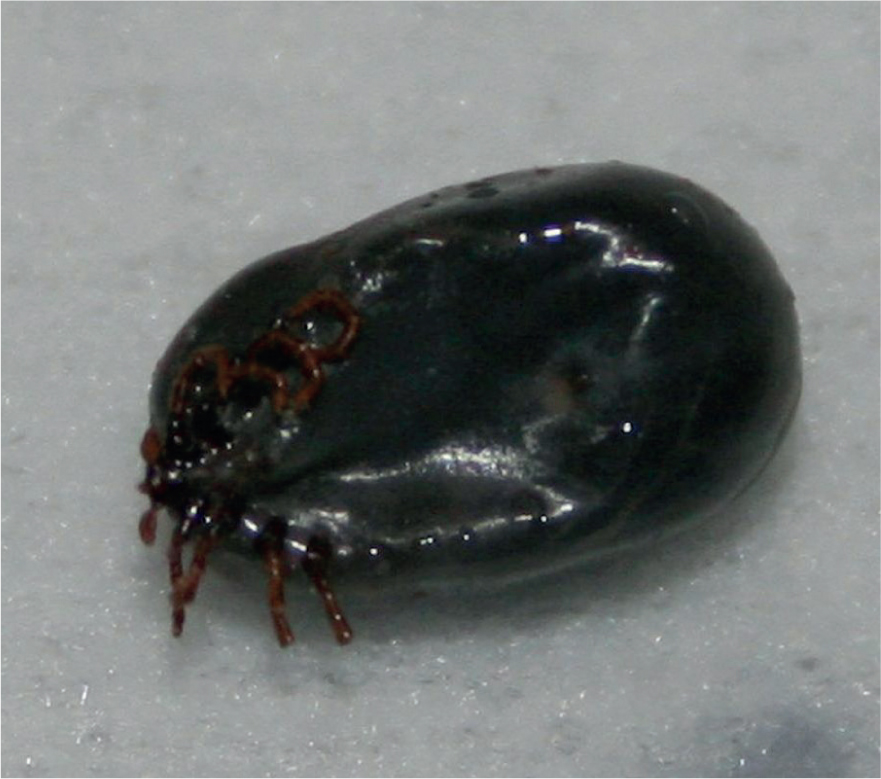
Lice
Lice are rare in rabbits, but the rabbit louse Haemodipsus ventricosus can cause irritation and in large quantities, anaemia. Treatment is with subcutaneous ivermectin injections.
Endo parasites
Nematodes
Several types of roundworms can affect rabbits. Examples include Trichostrongylus retortaeformis, Graphidum strigosum, Obeslicoides cuniculi and Passalurus ambiguous (Harcourt-Brown, 2015), however, most of these are only found in wild rabbits.
The most common of these encountered in pet rabbits is P. ambiguous, often termed as pinworms or threadworms. These are specific to rabbits and not zoonotic. They must not be confused with human threadworms, which are an entirely different species.
The worm is thought to be non-pathogenic in adult rabbits and may have a role in mechanical mixing of ingesta in the caecum (Varga, 2014). In young animals, or where there are clinical signs, such as weight loss, an unkempt coat or an enteritis complex, treatment should be commenced. Fenbendzole has been suggested as a treatment option. Rabbits will pass the worm between in-contact rabbits, as the eggs and live worms are passed out in the faeces and caecotrophs. These are between 0.5–1cm in length and often live when passed, but within a few minutes the worms dry out and die. Therefore further spread or reinfection is common since rabbits perform coprophagia.
Rabbits do not generally require routine worming for prophylactic control of nematodes.
Cestodes
Rabbits are intermediate hosts for several tapeworms that affect dogs and cats and pet rabbits that graze in gardens inhabited by pet dogs or visited by foxes can become infected (Varga, 2014). Taenia serialis and Taenia pisiformis are the most common tapeworms that cause cysts in rabbits.
The usual route of infection is by ingestion of contaminated plant material infected by faeces from dogs or foxes that have the cestode.
T. pisiformis forms cysts in the abdominal cavity, while the cysts from T. serialis form in the tissues under the skin (behind the eye or in the tongue or muscles). The swellings that occur as a result of cyst formation can grow to a substantial size and contain the scolices (segments of the tapeworm). Clinical problems are observed due to the size or location of the cysts, and may require surgical removal in these cases.
Coccidiosis
Two forms of disease have been described in rabbits: intestinal and hepatic (liver) coccidiosis. Nevertheless, several species of this parasite have been reported to be able to infect rabbits (Mancinelli, 2015).
Eimeria stiedae is the species capable of causing hepatic coccidiosis. The remaining species of coccidia (Eimeria irresidua, Eimeria magna, Eimeria perforans and Eimeria media, which are the four main species in rabbits) are found in the small and large intestine, and are responsible for intestinal coccidiosis (Mancinelli, 2015). Young rabbits (under 8 weeks of age) are more commonly affected by the intestinal form.
Food and water become contaminated with the oocysts (eggs) by an infected rabbit, which are then ingested by another rabbit. Clinical signs vary and may include: intermittent to severe diarrhoea, with or without mucus or blood; weight loss; and dehydration. In severe cases death can rapidly occur due to intestinal dysbiosis. Hepatic coccidiosis occurs when E. stiedae pass from the intestines, through the bile into the liver and eventually in the faeces (Mancinelli, 2015). Symptoms vary depending on numerous factors, including the rabbit's age, parasitic burden and parasite involved. Stress can also determine the prospect of a rabbit developing clinical signs. Many rabbits can be asymptomatic, but when clinical signs are shown these can include: diarrhoea; anorexia; a distended abdomen; compromised liver function and bile obstruction. Oocysts can be difficult to distinguish from other parasites on examination of faeces under a microscope and are shed intermittently. Where death occurs, a post-mortem examination may reveal lesions within the small and/or large intestine or liver, depending on the species of parasite involved. Histology samples should also be submitted of the affected organs for confirmation. Several treatment regimens have been suggested to prevent and treat both forms (intestinal and hepatic) of disease associated with coccidial infection. Tortrazuril is, at present, considered one of the treatments of choice. Alternatively, specific antibiotics with anticoccidial activity may be administered (Mancinelli, 2015).
Conclusion
There are numerous parasites, both endo and ectoparasites, that affect rabbits. Some of these are asymptomatic and may play a part in the healthy balance of the rabbit's gastrointestinal tract and do not cause clinical signs when the rabbit remains healthy. If the rabbit's immune system is compromised for any reason, or their general health poor, then some of these parasites can begin to cause clinical signs. Many are also transmittable between rabbits and easily spread, so treating all in-contact rabbits and a thorough clean of the environment is important to reduce the likelihood of further infections. The majority are relatively easy to diagnose and treat effectively.
Key Points
- Many parasites are carried by rabbits sub clinically and may not cause clinical signs.
- Treatments may not be licensed for use in rabbits but information is extrapolated from what is effective in dogs and cats.
- Accurate diagnosis is important to ensure the correct treatment is implemented at the earliest opportunity.
- Some parasites can play a part in the healthy balance of the rabbit's gastrointestinal tract.
- Often all in-contact rabbits will need treating even if they are not showing clinical signs.


